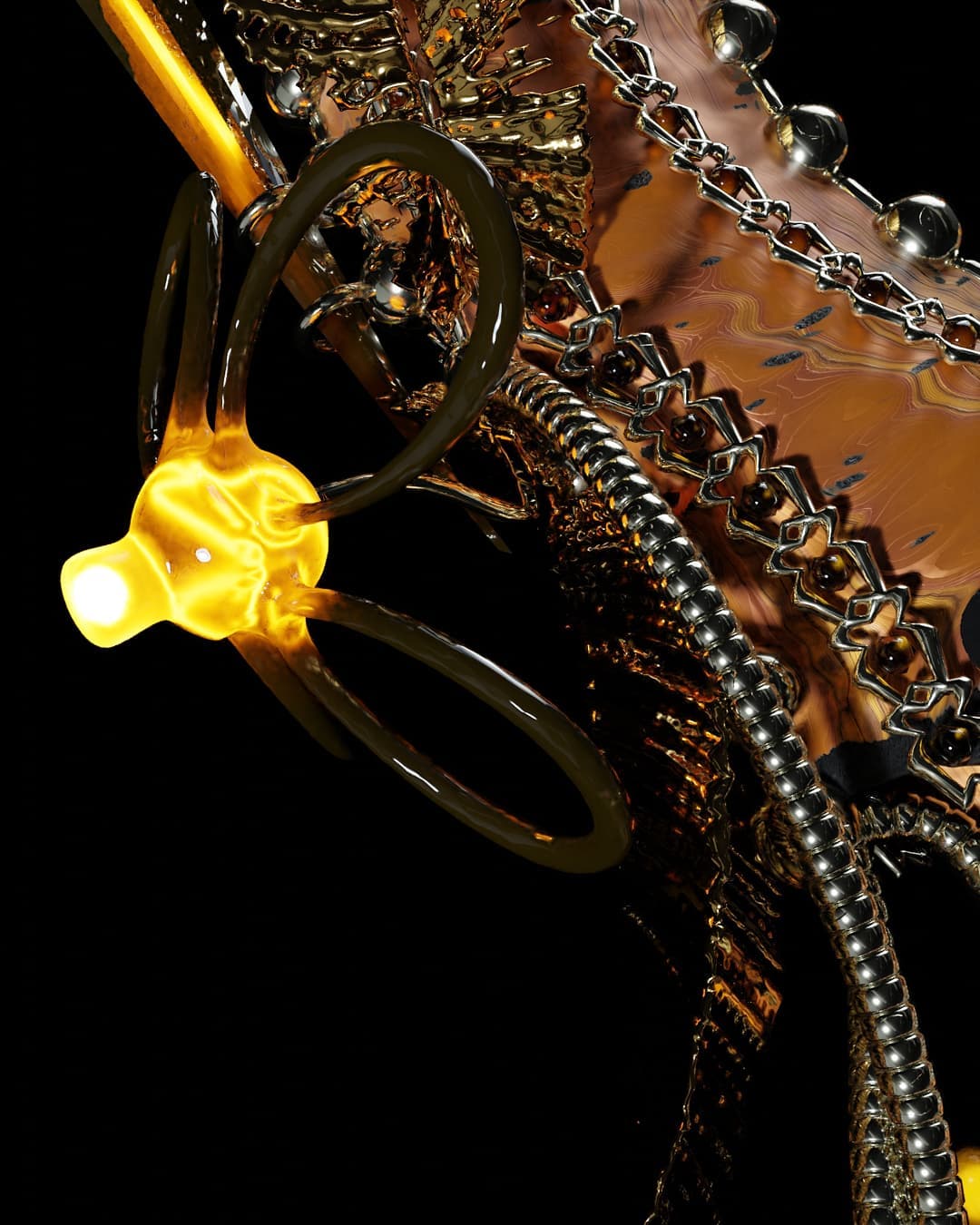Slow
Conversations
Issue: On Technological Materiality
Issue: On Technological Materiality
William Samosir is an Indonesian born artist and musician currently based in Brooklyn, NYC. His creative practice focuses on the field of 3D modelling, and his work aims to contribute to the futurist visual language of Southeast Asia. By summoning traditional and transcontinental aesthetic sensibilities within the speculative re-designs of historical artefacts, his work strives to merge the past and the future into a body of fiction. Will is also a member of a collective based in Indonesia and he currently works as an engineer and CTO at a 3D knitting startup. He plays the guitar and loves everything related to myth, artefacts, and spirits. His favourite drink is Ito En Oi Ocha.
Filed under: archaeology, design, technology

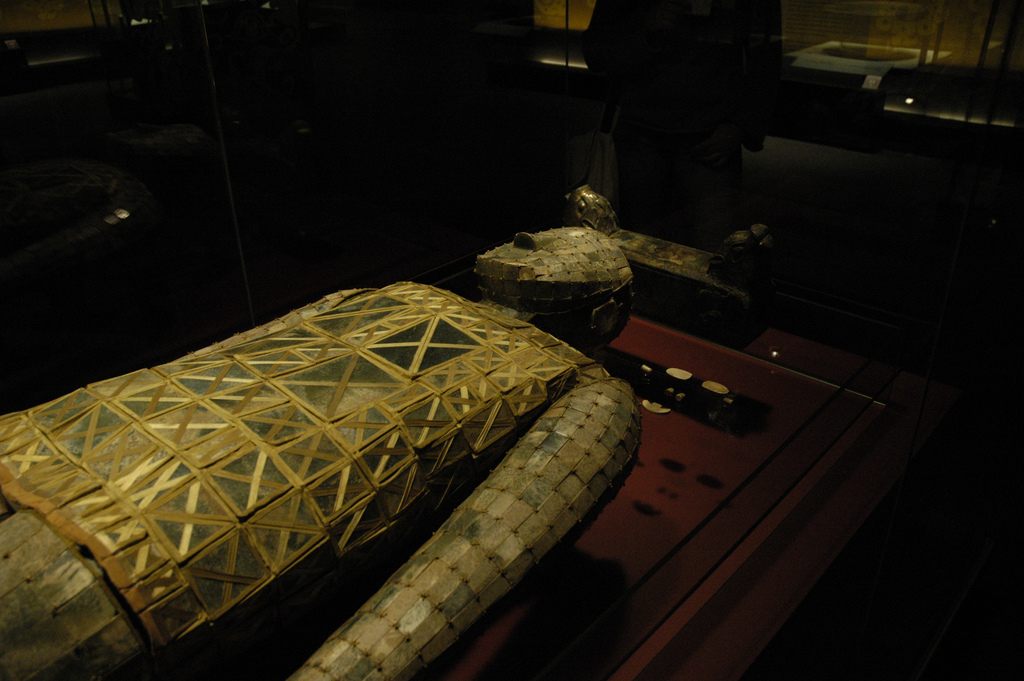
¹ Jade burial suit of Princess Dou Wan
Late 2nd century BCE, Collection of Hebei Provincial Museum
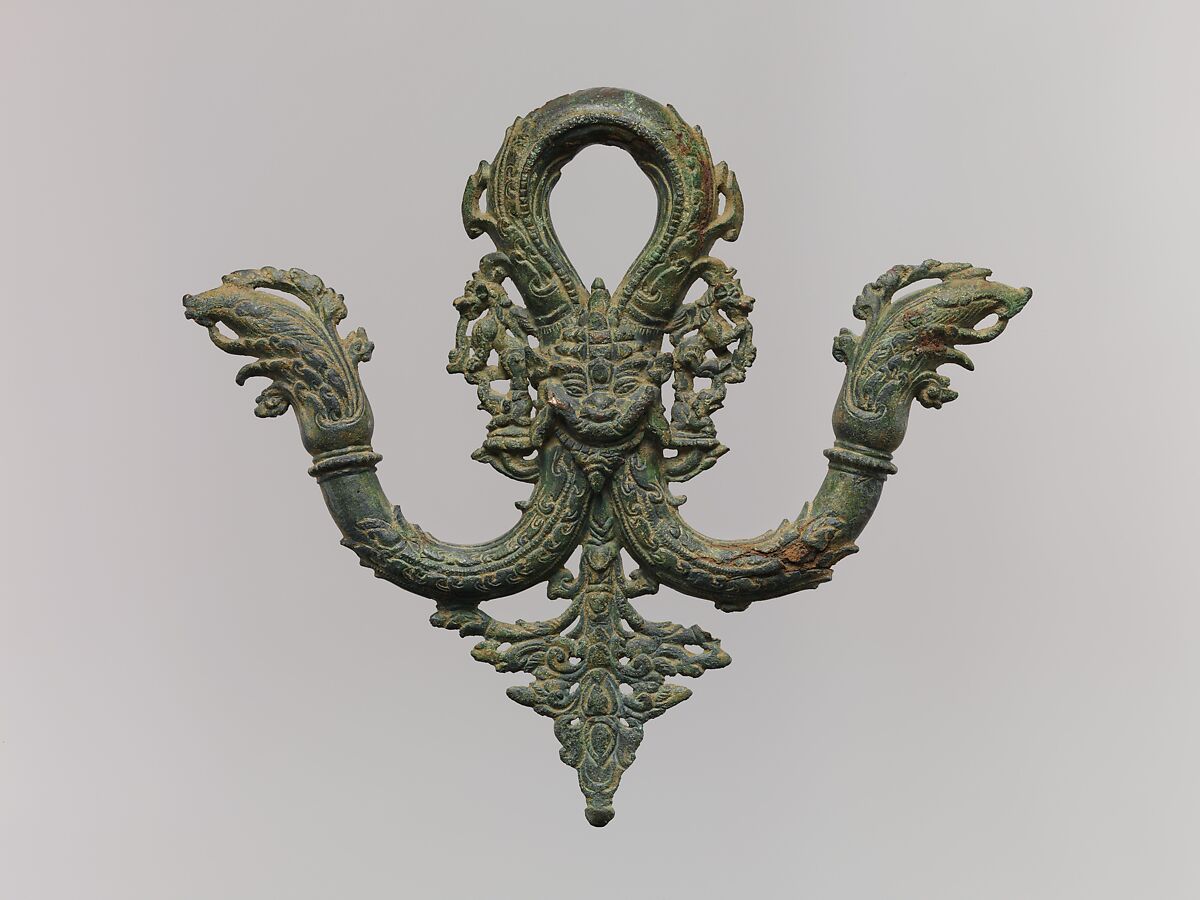
² Architect's plummet
c. 12th century, Collection of The Metropolitan Museum of Art, New York
Let’s open this conversation by talking about two historical items you picked out for this conversation. One is the architect’s plummet from 12th century Sri Lanka, and the other are the jade burial suits from Han dynasty China. Could you tell us about how you first encountered these objects, and what about them has left a lasting influence on you today?
informed the way you approach painting within your practice?
Out of the two objects, I encountered the jade burial suits first. It's funny—I encountered them online whilst researching how to create jade material on Blender. One thing led to another and I ended up at the jade burial suits. I remember being completely entranced by it, even though it was a digital image. I remember thinking that this item had such an aura to it. It was similar to encountering an object I would consider to be enchanted. It's a combination of a few elements — learning about its context as a ritual object for bringing royalty to the afterlife; the fact that each of the jade slabs were connected with golden wire; and that it has an uncanny look, almost as if it’s a 3D model. Jade was also a material that could only be owned by descendants of the royalty — if commoners were to own jade, it was considered a crime. I was interested in how it has been displaced from its original function and historical role, with the freedom to interpret how the object came to be.
I encountered the architect’s plummet in real life. It’s an artefact currently housed at the Met. When I first saw it, I was rather confused, and challenged myself to guess what it was without reading the text. I visited the Met four times but still could not figure it out. After finding out that it was a plumbob that was used in construction and to survey perpendicular lines in a temple, but yet it was made so ornately, I thought, “What a way to embed a narrative within a mundane, everyday object.”
Definitely. Both objects are fascinating artefacts of a particular history and culture. They both not only serve functional purposes, but have a mythological and symbolic significance as well. The architect’s plummet was used in the construction of temples and yet is inscribed intricately with a kirtimukha face. The jade burial suits were made to prevent mortal decay, but failed to prevent the deterioration of the bodies; yet interestingly, some suggest that because jade is permeable, their DNA could still be embedded in the stones, and in some ways, they still live on. When reimagining these objects, how do you consider both their functional and symbolic properties?
That’s fascinating, about jade being permeable. With the jade burial suits, what fascinates me most is the idea of the afterlife as a simulation. I remember a friend once approached me for a project and he wanted to create renderings of paper sculptures of phones, cars and ships, as symbols of good luck and fortune. Similarly in the burial practices of the Han dynasty, there would be jade miniatures such as little houses, trees and animals placed next to these burial suits. It’s super fascinating — you would not just have a burial suit, but all these auxiliary objects that are supposed to be props, almost, for one’s afterlife, perhaps preordained for themselves prior to dying.
It's interesting how jade, even though it’s hard, has a simulative property for the afterlife. Aside from displacing my Protean gloves from its royal status, the gloves can also be ever changing and not static. This was the first render I did where I felt something click. This was more of an intuitive sketch. However with the Jade Mask, it was specifically commissioned for a project on speculative future thinking. Hence there was more consideration around questions such as: why jade, why is it ever-changing, and what does it have to do with capturing your likeness? That was how I negotiated the aesthetic quality and the previous historical context of jade.
³ Protean Gauntlet,
William Samosir
2021
⁴ PROTEAN, William Samosir
2021
2021
⁴ PROTEAN, William Samosir
2021

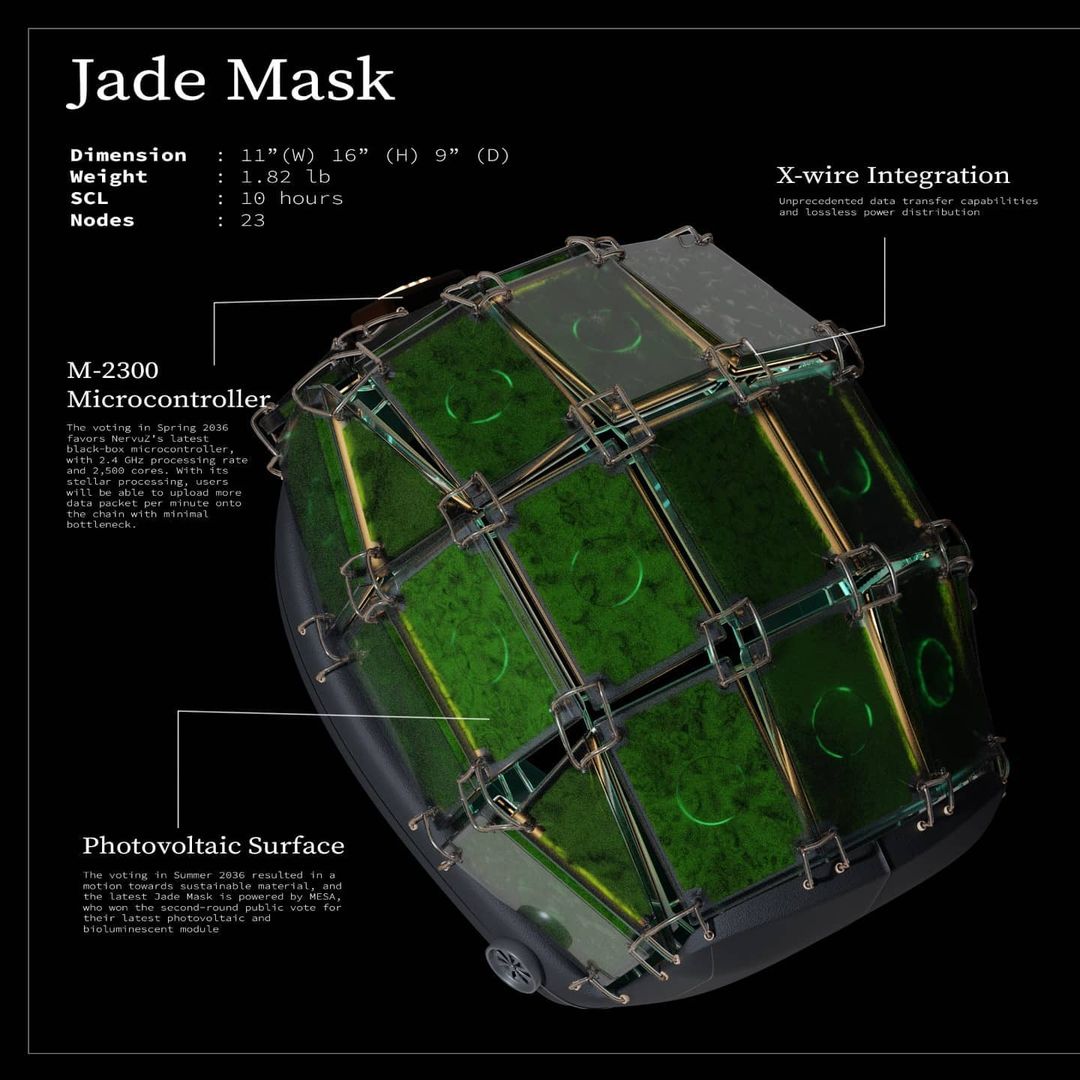
In our previous conversations, you’ve spoken about your endeavour to build a futurist language of Southeast Asia. In your works, you’ve drawn inspiration from various historical artefacts across wider South, Central and Southeast Asia. What does a futurist visual language of Southeast Asia mean to you, and how do you navigate the complexity and scale of such a diverse region?
I always have to start with Indonesia. It’s the visual language I'm closest to because I grew up with it. There are certain visual cues and elements that just make sense to me. But if we’re going to talk at a higher level, it is a reimagining of the modern visual culture of Southeast Asia that still honours the transcontinental assimilation that happened, especially along the Silk Road trade routes. I find it crazy that the Kirtimukha, for example, came from Sri Lanka and South Asia, and made its way all the way to China and down to Southeast Asia. In Bali, we have something very similar called barong. To me, that’s just a way of saying that we honour everyone's mythology whilst incorporating it into our culture and everyday lives to create local connections. There's that transformation of a foreign object into something that is a part of your everyday life. My renderings draw mostly on Indonesian and Southeast Asian references, but I try to branch out by referencing symbols like the Kirtimukha or the Vedic Naga. To me, a futurist language of Southeast Asia is an amalgamation of all these influences.
In terms of how I navigate it, I am still figuring it out, It is huge, and I am by no means an anthropologist or historian, but I find myths incredibly fascinating. I often listen to podcasts on Southeast Asia, and there’s a good one called New Books in Southeast Asian Studies. They talk about the Tang shipwreck in one episode, and they talk about the construction of morality around food in Southeast Asia in another excellent episode. I try to be in touch as much as I can, but when it comes to navigating through visual culture, I’m a very intuitive person. A lot of it comes from seeing similarities in visual cues. Something I see in the Asian Civilisations Museum could remind me of something I saw in the Tibetan wing at the Met, thereby makes it into my renderings.
My renderings draw mostly on Indonesian and Southeast Asian references, but I try to branch out by referencing symbols like the Kirtimukha or the Vedic Naga. To me, a futurist language of Southeast Asia is an amalgamation of all these influences.
⁵
Architect’s Plummet,
William Samosir
2022
⁶ Cloud Devourer, William Samosir
2021
2022
⁶ Cloud Devourer, William Samosir
2021
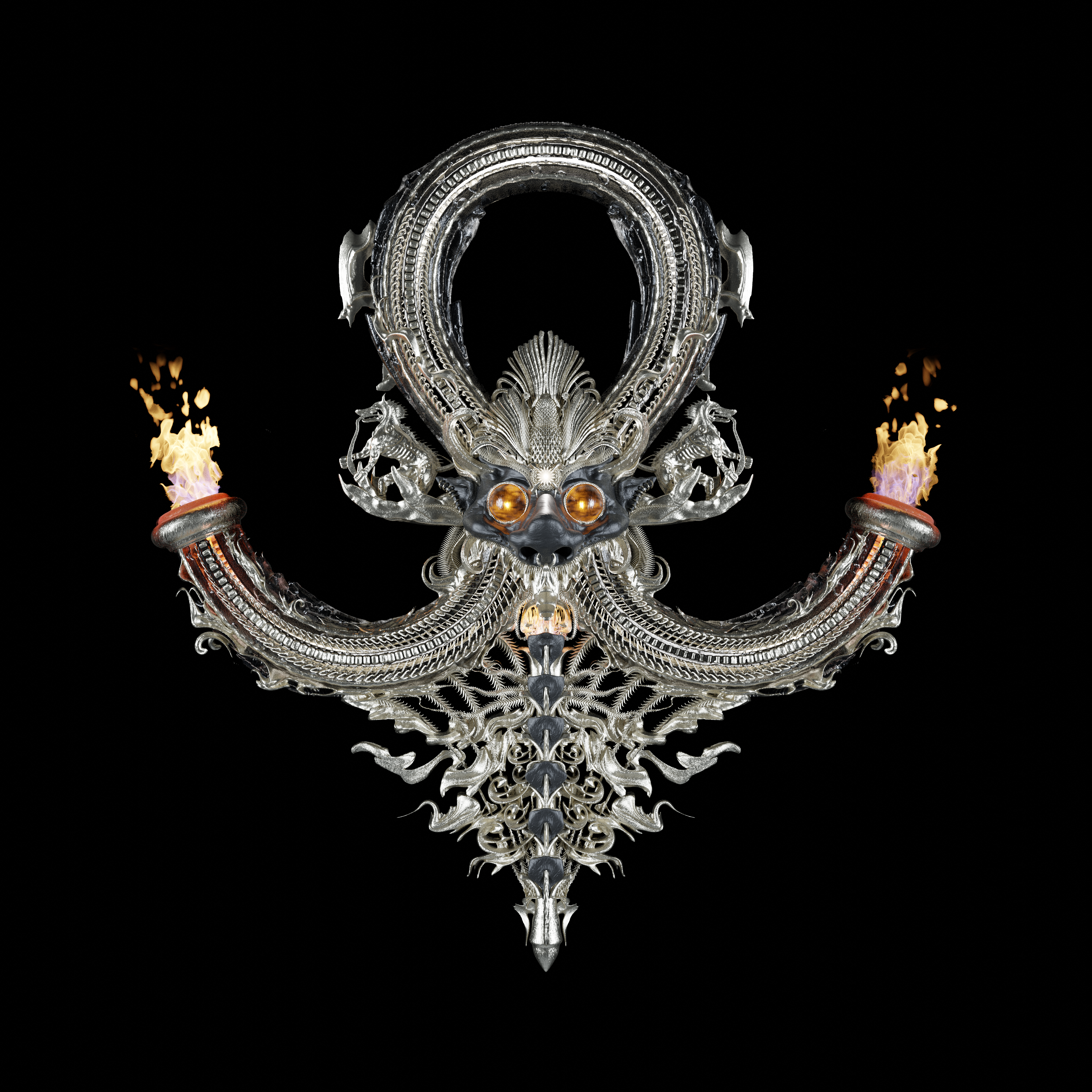
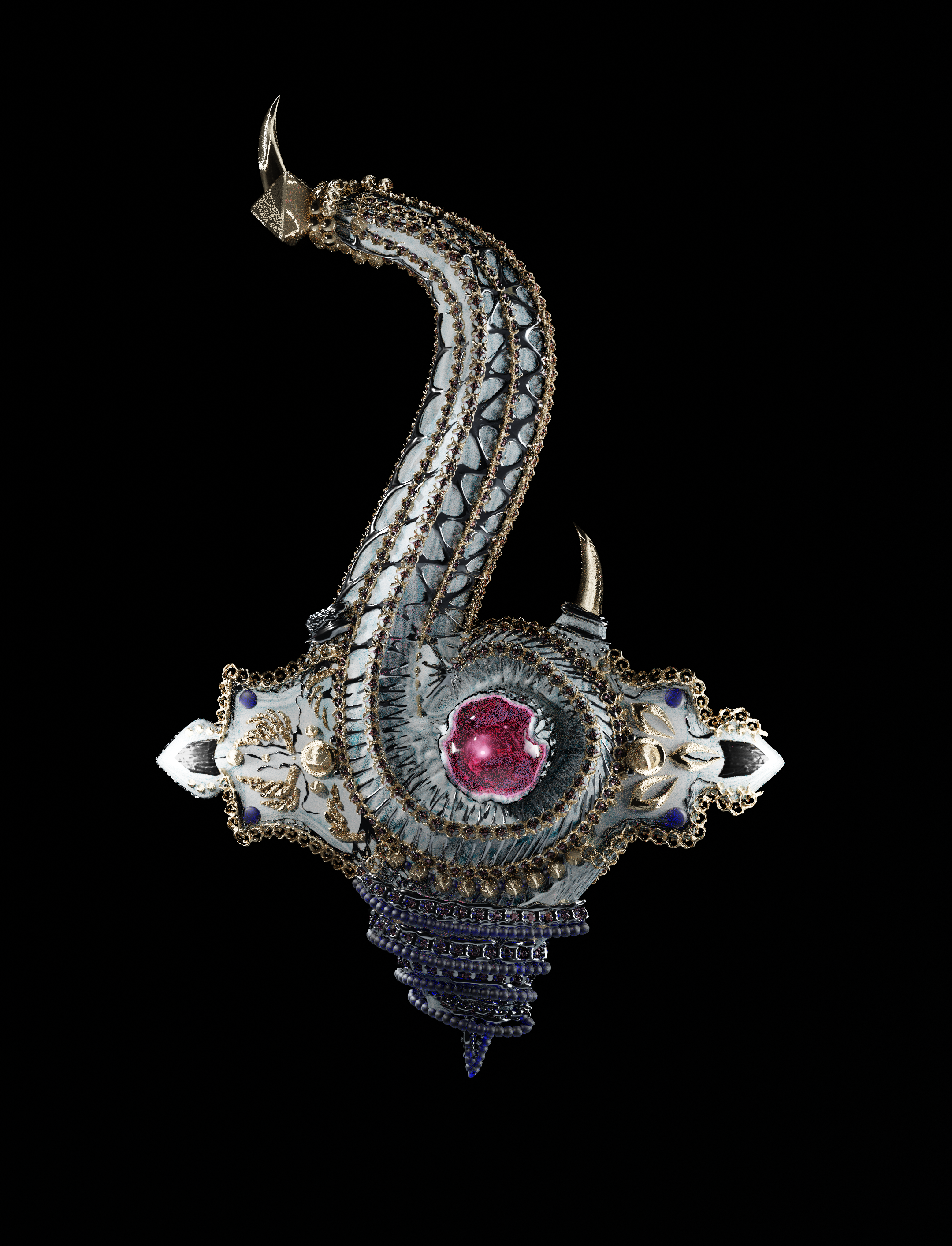
How do you navigate the process of working such a far distance away from Indonesia and Southeast Asia?
I work with a collective in Indonesia, which has really helped because you’re throwing these ideas to people who live their day to day life there. When I’m putting out a visual concept that is affirmed, it feels like it’s not just me imagining something from a faraway land. But at the same time, it really helps having a community of people who are also Southeast Asian or Asian in New York. When we talk about historical artefacts or things we did as children, it often feels like I'm engaging with someone who comes from the same vibration.
When making the render rewrites of these artefacts, how do you make decisions on what to include, exclude or alter? How much of it is influenced by its original history, context and function, and how much is an observation of our contemporary present or speculative future?
I try to negotiate both as much as I can. My point of view is that I were to just make a replica of an artefact someone made three thousand years ago, it's almost as if I am not honouring their work. In some ways, I'm not interpreting their work — I'm not consuming it, regurgitating and outputting it as something that I’ve processed. I think it has to encapsulate our current time to really honour that knowledge.
With all the artefact renders that I do, I always research what they mean first. None of the renders have been done on the pure basis of visual and aesthetic function because it could easily slip into appropriating and exoticising these objects in the same way that museums do. For example, the Singa pendant has a protective meaning in Batak culture, where I am from. As much as I can, I have to include anything that is core to the story of the Singa. Even if I want to overturn language on its own head to retell the story of the Singa as non-patriarchal (as the culture is very much driven by patriarchy), I have to understand and explore the original context.
At the same time, the process of excluding and including elements comes from intuition for me. It's hard for me to formalise some of the decisions that I make. Some of them just feel right at the moment. At the very end, to feel that the artefact is complete is also a strange thing. I would say my work is ritual. There is the process of making the render and feeling at the very end that I have transcended something. There is a certain threshold that can’t really be explained, but when you’re done with the render, it feels like you’ve gone beyond what you think of as ordinary.
⁷
Singa Pendant,
William Samosir
2022
2022
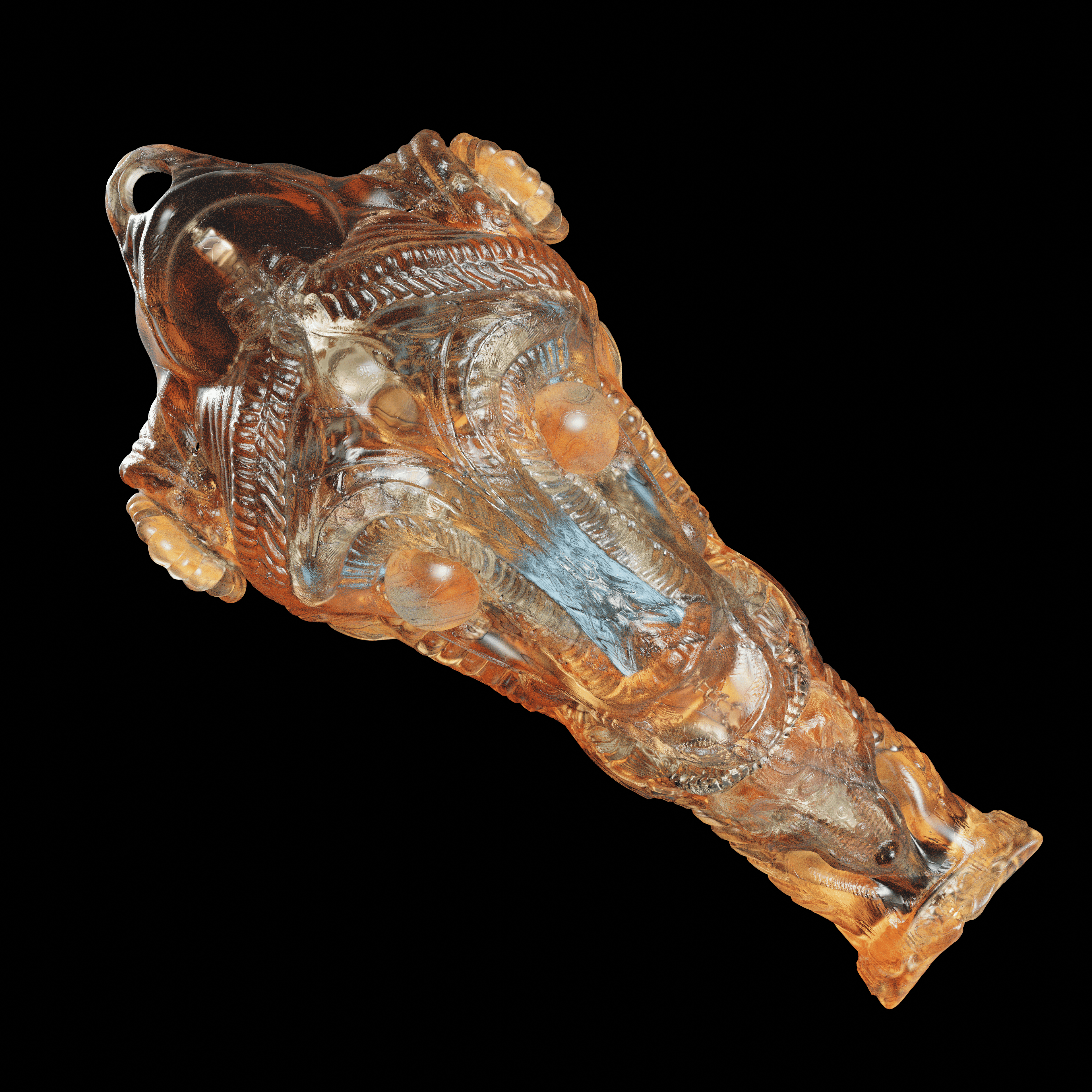
In some ways, it seems like a process of discovery through making — you come to a certain point where you’ve spent enough time with it, you’ve given it thought and this is what has come out of it. At the same time, you’re also giving form, shape and body to the immaterial. I’m reminded of the one render you made based on a dream you had where materialised and visualised the mutability and murkiness of the dream.
Now that you bring up the dream, one thing I would like to add is that something clicked for me when I was listening to the podcast I mentioned earlier. Natali Pearson was talking about these artefacts from the shipwreck as answers to their afterlives. These objects are displaced from their original contexts. It might have previously been used for meals, but now it lives in museums.
When it comes to manifesting my dreams and making these renders, there are aspects that feel like I'm giving form to a kind of spirit. But I'm not quite sure yet how to frame the spirit itself yet.
 ⁸ An Inventory of Losses, Judith Schalansky
⁸ An Inventory of Losses, Judith Schalansky 2018
That leads nicely to another reference you picked out for the conversation, Judith Schalansky’s An Inventory of Losses. It speaks to the speculative histories of objects which have been lost to the world. Tell us this book has been particularly inspiring for you.
This book is amazing, I first read it in 2020. It was the first time that I finally understood why this whole project on historical futurism made sense. The Inventory of Losses is essentially a collection of twelve things that have been lost to the world, but whose existences can still be traced through paper trails and other documentation. What Judith Schalansky does in that book is to create a speculative history of these objects — to make fiction about something that has already passed. If you can do that with history, it struck me that you can also rewrite artefacts. It goes back to the idea of how we can engage with an afterlife of an object, given that our knowledge about it is very limited.
Especially thinking about ongoing conversations around the repatriation of artefacts from the Netherlands to Indonesia, interestingly there has been resistance from some curators and archaeologists from Indonesia as they say we don't really have the infrastructure in Indonesia to house these objects. But all of this is so much more complex than just repatriation. It does not take into account geopolitical tensions and museum relationships. Ideas of ownership are also complicated. How do we engage with these things that we can only see perhaps as images online or in archives and museums? After reading this book, I thought that we could actually make speculations about these objects’ history and their futures, particularly given our murky knowledge about them.
I’ve observed that materials and materiality play a big part in your work. When you mentioned the jade burial suits, you said you were obsessed with jade for a long time. In your renderings, you often go to great lengths to capture or transform the materials of these objects. In Singa Pendant, for example, stone is transformed into a translucent gelatin-glass-amber-alabaster hybrid material. Tell us about the role of materials in your work, and why you are drawn to particular materials, especially when you are trying to capture their visual qualities in digital space.
I've always loved materials. I really love touching things and altering them in real life. I collect a lot of objects and trinkets just for inspiration. One thing that was eye-opening for me was working in Blender. It’s akin to working with the hand of God in that when you’re making materials, it's literally unlimited. Maybe it's also related to the fact that I love programming. I love thinking about volumes and surface quality in terms of mathematical equations. In Blender, you can do that: connect a bunch of nodes and solve matrices. You can create something that is so otherworldly and so ambiguous that it's almost like you're not in this world anymore. When you're looking at this artefact, you are transported someplace else.
I started off really looking at materials when I did sculpture for school, and I loved it. Given this love for materials, one might ask why I bring them into digital space? It was probably a little unclear at the start, but lately I’ve started to figure it out. It's because the digital space lacks materiality. We are essentially just seeing visual information on screen. One challenge that I’ve taken on for myself is how I can summon that feeling of material-ness, just through an image. If I can accomplish that successfully, it’ll be just like a magic performance. You’d see something you feel like you can almost touch, and become confused about its depth and its wholeness. A good way to think about it is an enchantment of digital spaces.
One challenge that I’ve taken on for myself is how I can summon that feeling of material-ness, just through an image. If I can accomplish that successfully, it’ll be just like a magic performance.
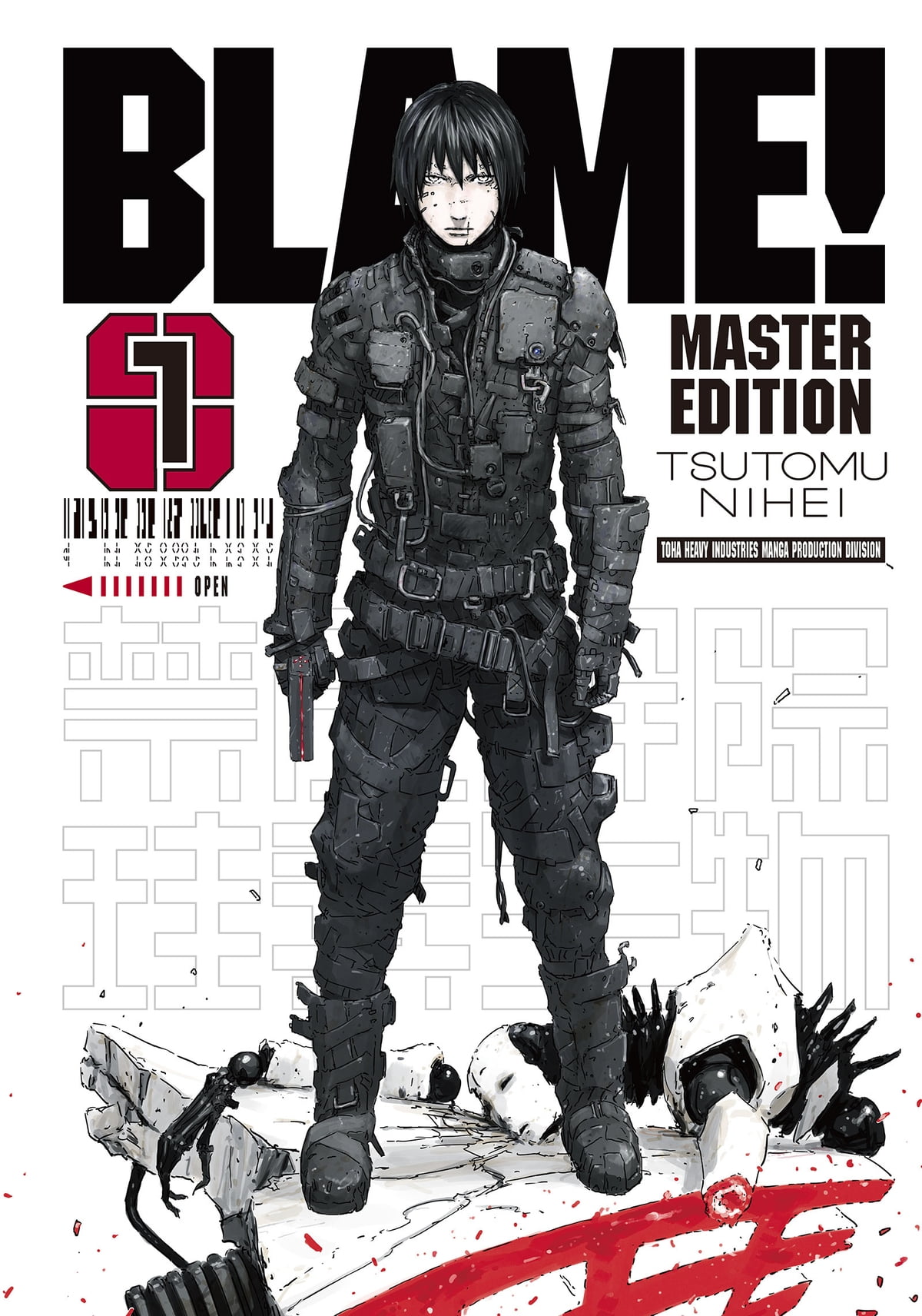
⁹ BLAME!, Tsutomu Nihei
1997-2003
This is a good time to talk about the Japanese cyberpunk manga, BLAME! What was it about this manga that left a lasting impression on you, and why did you choose it?
A co-worker introduced me to BLAME! It first came out in 1997, but its imagination of science fiction went way beyond what was mainstream science fiction at that time. The Matrix has nothing on BLAME! The comic has an interesting way of panelling. Between one panel and the next, sometimes thousands of years could have passed.
It also has an interesting way of rendering reality against the backdrop of a virtual world without a boundary between the two. You can't really tell if these entities are virtual or real. Is there even any distinction between virtuality and reality in this world? It also creates a feeling of space within each panel very well. For example, a character could just be walking in a panel and it's silent. There are also other panels with high paced action, but these later go back to silence.
Even though they are just images, the sensations and materiality they invoke and summon were so profound to me. I felt that this was the ultimate use of the manga medium.
It's really interesting that you chose that as a counterpoint to the other references. Your background was in painting, illustration and sculpture, but now you work primarily with digital interfaces, 3D modelling and programming. Tell us about your journey with art. How did you come to working with 3D renders, and how do your previous experiences feed into your current practice?
When I was in my freshman year at Rhode Island School of Design (RISD), I thought I was going to do painting. There was no one who could stop me because I love painting. I consulted one of my teachers about a supplementary class I could take, and was choosing between a painting class or an electronics sound programming class. She said, “When else are you going to do electronics sound programming if you're going to do painting your whole life?” That’s how I ended up taking the class and eventually majoring in sculpture.
In junior year, I became interested in processing languages, and was struck by how it felt so natural for me to code. I like solving puzzles whenever I make visuals. Long story short, I ended up taking 3D modelling and circuitry classes. My capstone project took the form of two collaborative gloves that controlled an amorphous creature in VR space. It acted as a type of spatial instrument that would create sound when you hit items in space.
After I graduated, I did a bunch of fellowships. I still wanted to make art, however I didn’t have much access to physical materials. That was when I started taking up Blender and doing renders because it's all on your laptop, and it was all I had at the time. It has not been the same story since.
I feel that even through this conversation, your background and your network of references still draw strongly from illustration, sculpture, painting. I feel like that's why your approach is so unique because it merges the two.
I have to say that even though my medium has changed, my approach to image-making is still the same as my approach to painting. Even when I made sculpture, I always thought of them as paintings. Now I’m still making a painting with renders. I'm just moulding things in 3D and arranging them. At its core, it's still a painting to me.
When you're making renderings, you actually don't really get a full view of what it’s going to look like at the end. You're working with a material preview. Sometimes the way I make decisions about colours and where things are going to go is to think from a viewpoint of a camera. I would create multiple sketch objects that are placed here and there to form a composition from one angle. The final product might not be a painting, but a painterly approach is embedded into how I compose objects. Rendering boils down to image making. The next render I really want to make is of my great-great-grandfather, who could lift a bull with one finger. That will be a kind of painting.
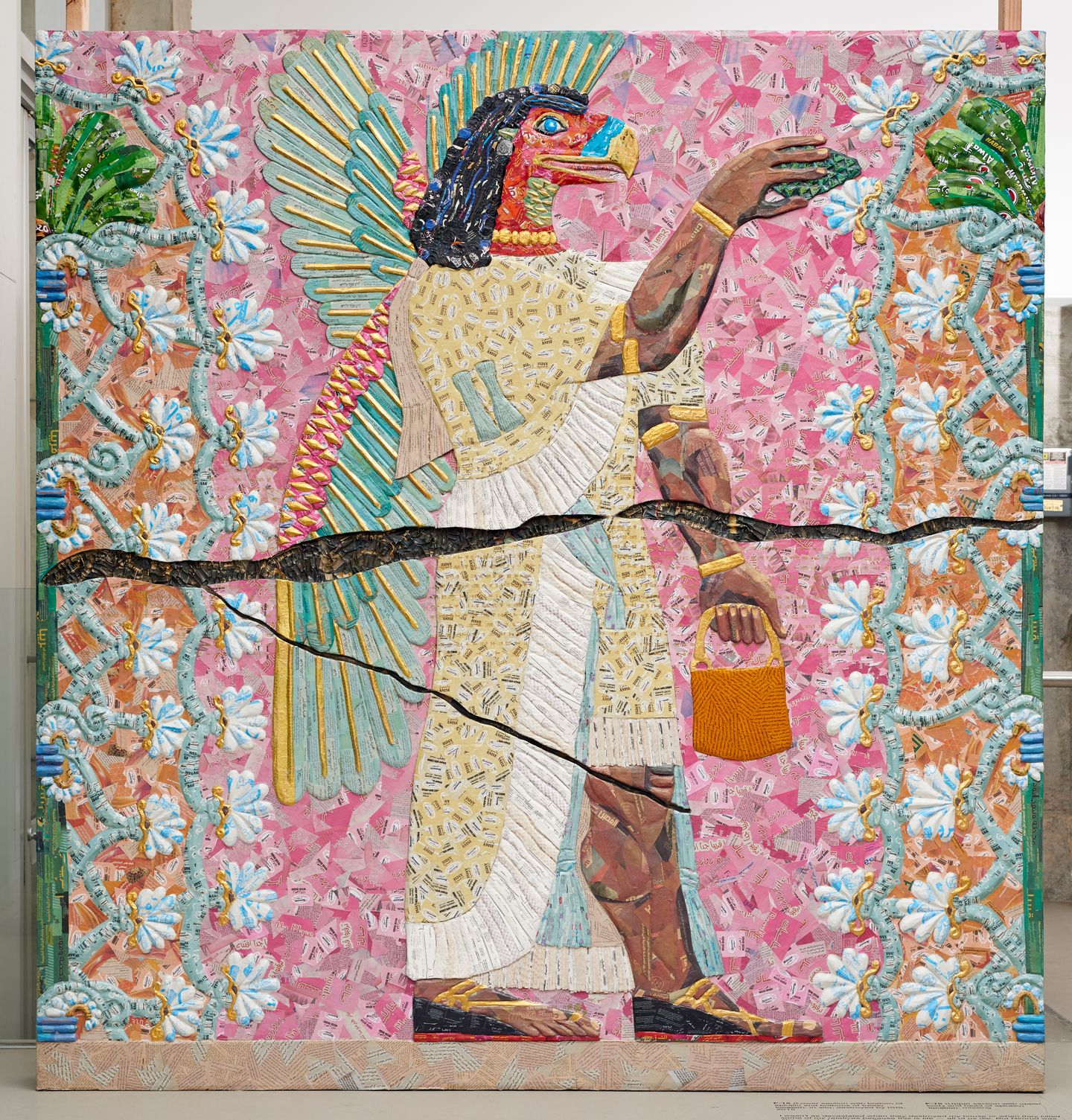
¹⁰ The Invisible Enemy Should Not Exist (Room F, Section 1, Northwest Palace of Nimrud), Michael Rakowitz
2021
Let’s talk about Michael Rakowitz’s The Invisible Enemy Should Not Exist, which you encountered at the Armory Show. In this work, the Iraqi-American artist manipulates Middle Eastern food packaging and other materials into vibrant collages which recreate stone carved panels destroyed by ISIS. His reconstructions speak to loss, memory, conflict and history. What was your response to this artwork, and how have you seen that response reflected in your work?
I saw this work in the Armory Show, which is essentially a setting filled with white walls and commercial galleries. But there is a big open area in the centre where they usually exhibit big works. Michael Rakowitz’s piece was in this area against a wall panel. I was walking in and when I looked right, I immediately felt that something wasn’t right. I felt like I had seen this panel before somewhere. It was one of the panels that was featured in the news during the destruction of Palmyra, with Horus, the falcon-headed god.
The work has a kitsch appearance with colours of pink, white, and yellow. When I went up to see what it was made out of, it displaced and transported me to a weird liminal space between witnessing an artefact coming back to life, whilst seeing something so abject and mundane organising themselves around this holy and venerated object. Elevating a destroyed artefact with something as mundane as food packaging had such a transformative power to it.
Yes, his works speak so strongly to the impact of the conflict on everyday life, and have so many resonances with your approach as well. I was also thinking a lot about how your rendered objects would function within a larger narrative. Right now, we encounter them as individual pieces, but I wonder about the world in which they could all come together at some point. Do you see them in isolation, or as part of a collective worldbuilding?
To be very honest, I’ve never really thought about an auxiliary world for this project. Right now, I do see them in isolation because they are so disparate from each other. The Jade Burial Mask references the Han dynasty; the Architect’s Plummet is from Sri Lanka; the Singa Pendant is from Sumatra; the Burial Mask is from Java; and other things are from the Met. I don't know if I've created an environment for all of them to live together, but it’ll be interesting to build a series of objects that exactly describes something other than itself. These are artefacts, but they essentially transport you to someplace that is not itself – a process that is not dissimilar to world building.
Maybe it's similar to how Michael Rakowitz thinks about recreating the panels. Those panels were real life objects, but it's almost like seeing a ghost to encounter its recreated form. The panels are now made of everyday mundane objects. In my artefacts, even though they're extremely ornate and maybe a little bit-off scale, I always defer to realism. I want them to be believable and to feel as if you can, at this very moment, have that artefact in front of you, even if they are somewhat otherworldly. I never really thought of them as something that exists in the future or something that exists in the past. I imagine them as something that lives in the present — as an apparition.
In my artefacts, even though they're extremely ornate and maybe a little bit-off scale, I always defer to realism. I want them to be believable and to feel as if you can, at this very moment, have that artefact in front of you, even if they are somewhat otherworldly.
¹¹
Sukma Funerary Mask with Substrate, William Samosir
2022
¹² Sukma Funerary Mask with Substrate, William Samosir
2022
2022
¹² Sukma Funerary Mask with Substrate, William Samosir
2022

Tell me about your collective, Blanco Benz Atelier. How did you come together, and how has working in a collective fed it into your own practice?
Three of us went to the same school together. I’ve known Yura Kenn Kusnar since kindergarten, and Jeffi Manzani since middle school. It was just happenstance. I was in junior year of college and heading back home one summer, and I just wanted to make art. I hit up these two guys and we ended up doing a painting marathon at my house: a large collaborative painting on canvas that came out really blotchy and abstract. That’s how we started off. We ended up organising an exhibition about digital culture, working on collective projects, and more. But it's not just about making work. We're also utilising each of our skills. One person is really good at rendering, another is also good at Photoshop and rendering, and the final person is really good at fieldwork, writing, bringing people together, making connections and introductions. Our mix of skills and expertise complement each other.
We ended up doing a number of projects together. At the start it was just for fun, but it ended up being a little bit more serious. We work across futurism and other digital works, and now we are also part of gudskul, ruangrupa’s collective study space. That was really nice because we finally got guidance and context about how diverse collectives could be. It was really enlightening to learn about collectives who work in different ways.
We’re currently taking a little bit of a hiatus — as any collective does. I remember someone from gudskul telling me that the best collective is made of people who are strong and fulfilled individuals themselves. We're in that boat now where it's fine if we need to see to our own projects first before coming back together as a collective. People come and go, and people do take hiatuses or short breaks, but I think I wouldn't have explored anything about historical futurism or gotback in touch with Indonesian visual culture and language if it had not been for the collective.
That’s interesting because working collectively is very different, and everyone has their own rhythm and practice. The other curiosity I had was that you hold a day job in the fascinating field of knitting technology as a 3D engineer, web developer and designer. How has it been working in parallel with your artistic practice?
Whenever I have to program for eight hours because of my day job, I just have to be in front of the computer coding. I can’t go back to rendering after that because that's just my quota for the day in terms of being in front of my computer. It's really seasonal. I'm very thankful right now because I have more of a managerial role in my day job. This means I have to spend less time actually in front of my computer typing code up.
One thing that is really interesting about this job with 3D knitting is that it actually deals a lot with geometry. We think about geometry on a daily basis, and it's not just in terms of analysing geometry. We also think about what it means, for example, to propagate certain functions throughout a surface. In some ways, that relates to how I think about renderings — the creation of patterns throughout geometry and making shaders. Shaders are programs that you would write to change how a 3D scene is processed, and they have to be thought of as mathematical functions. Some of the concepts that I learnt for 3D knitting really changed the way I think about making shaders and materials. Everything just clicked after that, so I’d say a lot of the skills from work really feed into rendering.
That's really cool. The other core part of your practice is music making. Could you tell us why music and music-making is important to you, and if it provides a different mode of creative expression for you?
Remember I said I can't go back to rendering after eight hours? Music became the alternative. With art, I feel like there's a lot of give and take. It’s a slow grind where you make decisions and wait to see whether it works or not. With music and jamming, you make decisions right there right then. It's also about building relationships with the people you’re jamming with. I’ve been jamming with my bandmates for a year now, and we're just so comfortable with each other in space that navigating through notes and compositions end up feeling very natural.
In relation to how my previous practice feeds into my current renders, I feel music has a little bit of influence. I'm obsessed with repetition, and I use array functions where you repeat certain shapes, say, a trail of a curve, in my renderings. At the same time, you have variations in the way it is repeated. It could start out big, then shrink quite small, go even smaller, then expand again, before reducing in size, staying small, ballooning bigger again, size down significantly, and staying small. I use that a lot as a strategy in my rendering as well, and I see that as being connected to music.
I'm obsessed with repetition, and I use array functions where you repeat certain shapes, say, a trail of a curve, in my renderings.
¹³ Midrib Ear Ornament, William Samosir
2021
¹⁴ Midrib Ear Ornament, William Samosir
2021
2021
¹⁴ Midrib Ear Ornament, William Samosir
2021
